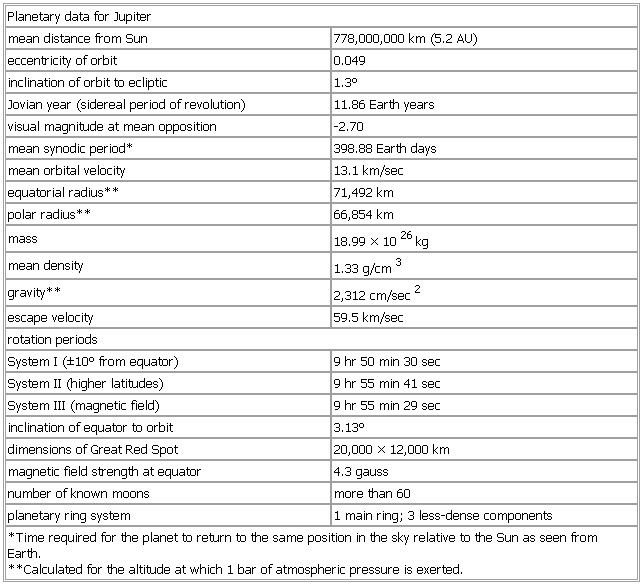Planetary data for Jupiter
- Planetary data for Jupiter
-
Planetary data for Jupiter
mean distance from Sun 778,000,000 km (5.2 AU)
eccentricity of orbit 0.049
inclination of orbit to ecliptic 1.3°
Jovian year (sidereal period of revolution) 11.86 Earth years
visual magnitude at mean opposition -2.70
mean synodic period* 398.88 Earth days
mean orbital velocity 13.1 km/sec
equatorial radius** 71,492 km
polar radius** 66,854 km
mass 18.99 × 1026 kg
mean density 1.33 g/cm3
gravity** 2,312 cm/sec2
escape velocity 59.5 km/sec
rotation periods
System I (±10° from equator) 9 hr 50 min 30 sec
System II (higher latitudes) 9 hr 55 min 41 sec
inclination of equator to orbit 3.13°
dimensions of Great Red Spot 20,000 × 12,000 km
magnetic field strength at equator 4.3 gauss
number of known moons more than 60
planetary ring system 1 main ring; 3 less-dense components
*Time required for the planet to return to the same position in the sky relative to the Sun as seen from Earth.
**Calculated for the altitude at which 1 bar of atmospheric pressure is exerted.
See as table:
* * *
Universalium.
2010.
Look at other dictionaries:
Jupiter — /jooh pi teuhr/, n. 1. Also called Jove. the supreme deity of the ancient Romans: the god of the heavens and of weather. Cf. Zeus. 2. Astron. the planet fifth in order from the sun, having an equatorial diameter of 88,729 mi. (142,796 km), a mean … Universalium
Planetary habitability — is the measure of a planet s or a natural satellite s potential to develop and sustain life. As the existence of life beyond Earth is currently uncertain, planetary habitability is largely an extrapolation of conditions on Earth and the… … Wikipedia
Jupiter — This article is about the planet. For other uses, see Jupiter (disambiguation). Jupiter … Wikipedia
Planetary science — Planetary science, also known as planetology and closely related to planetary astronomy, is the science of planets, or planetary systems, and the solar system. Incorporating an interdisciplinary approach, planetary science draws from diverse… … Wikipedia
Exploration of Jupiter — Jupiter as seen by the space probe Cassini. This is the most detailed global color portrait of Jupiter ever assembled … Wikipedia
Planetary mass — The four terrestrial planets in the Solar System, to scale. Note that Mars (to the far right) is about half the diameter of the Earth, but only one ninth of the mass … Wikipedia
Atmosphere of Jupiter — Cloud pattern on Jupiter in 2000 The atmosphere of Jupiter is the largest planetary atmosphere in the Solar System. It is mostly made of molecular hydrogen and helium in roughly solar proportions; other chemical compounds are present only in… … Wikipedia
Magnetosphere of Jupiter — Discovery[1] Discovered by … Wikipedia
Rings of Jupiter — A schema of Jupiter s ring system showing the four main components The planet Jupiter has a system of rings, known as the rings of Jupiter or the Jovian ring system. It was the third ring system to be discovered in the Solar System, after those… … Wikipedia
Moons of Jupiter — Jupiter and its four largest moons (montage) Jupiter has 64 confirmed moons,[1][2] giving it the largest retinue of moons with reasonably secure orbits of any planet in t … Wikipedia

